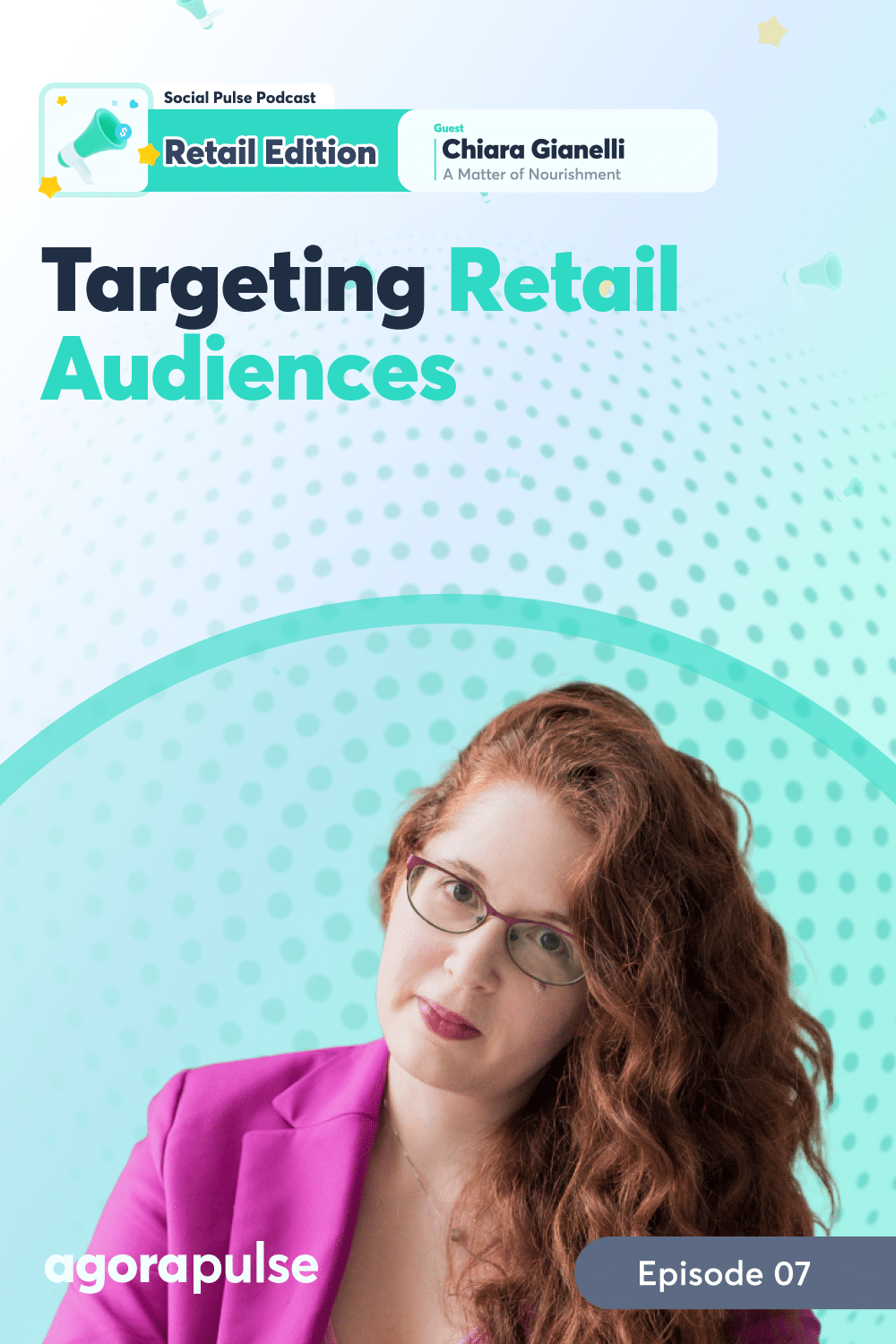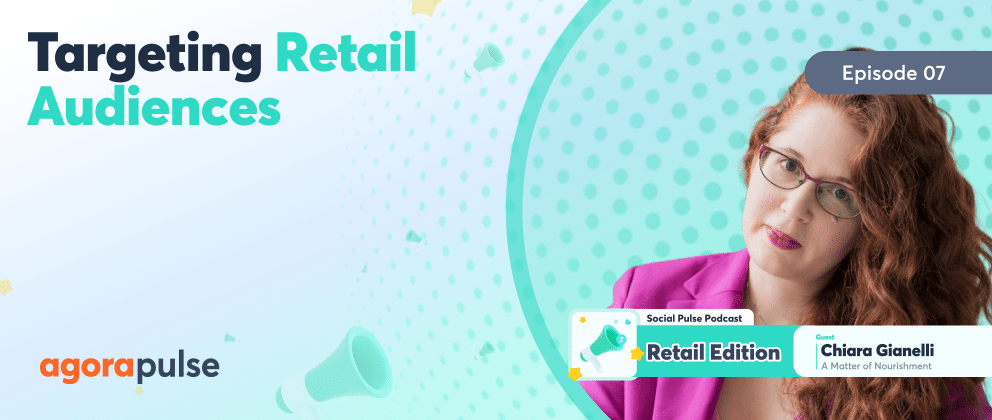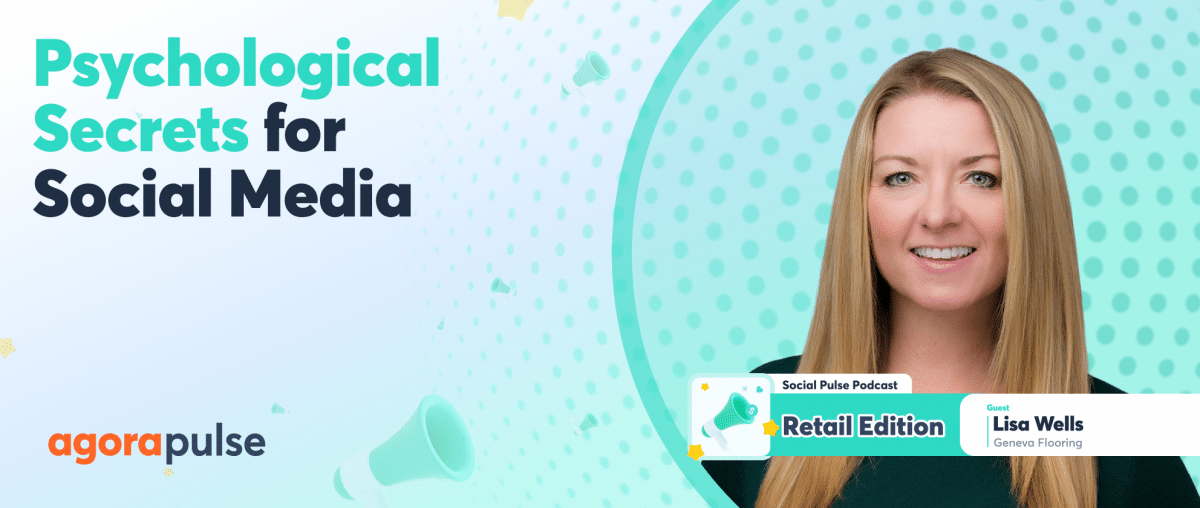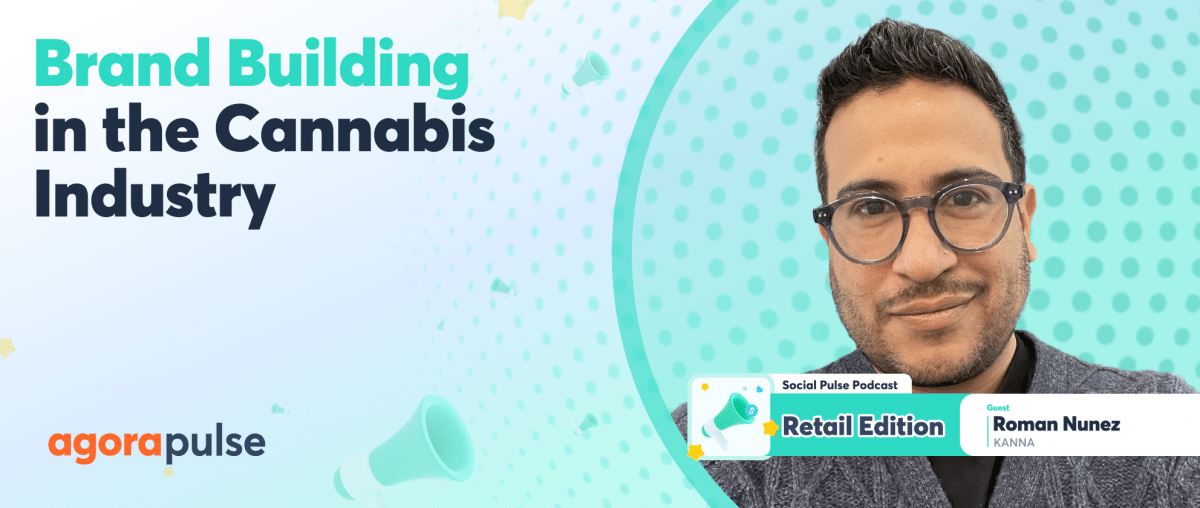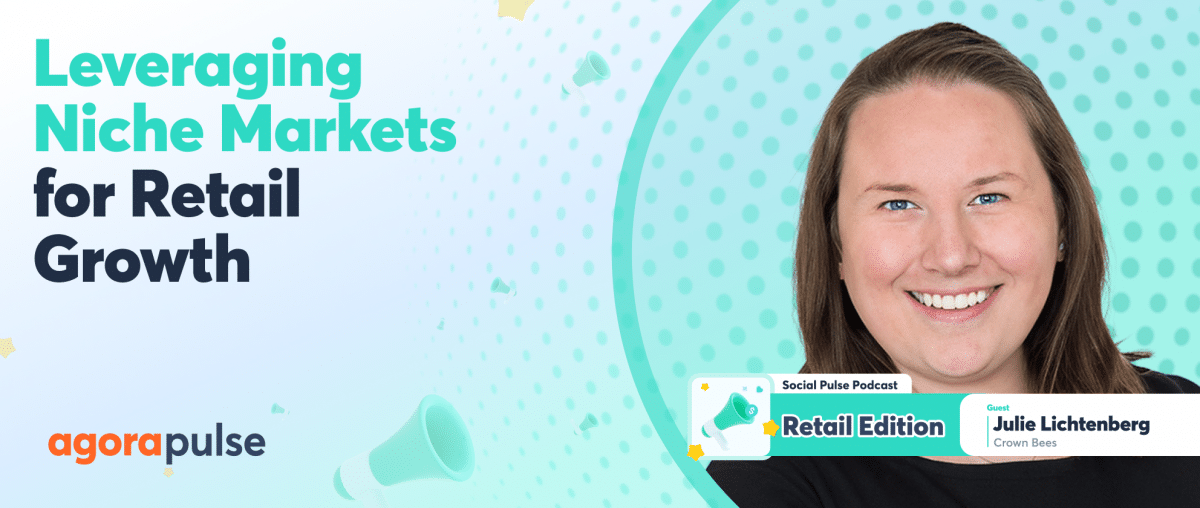As retailers, we know that segmenting audiences works.
We group similar items together in our stores alongside other items that would be of interest to the same shoppers. For some reason, when it comes to social media all too often, we think too broadly about our planned activities and strategies. We assume that everyone on social media at that very moment is a potential customer.
Why is audience identification and targeting so important on social media? And how can we get started as social media and community managers?
That’s exactly what Chiara Gianelli is going to talk to us about in this episode of Social Pulse Podcast: Retail Edition, hosted by Mike Allton. You can listen to the whole podcast below or read on for the highlights.
Chiara launched A Matter of Nourishment with a clear goal to help people improve their relationship with food. Initially, she focused on educating people with recipes, photos, and useful tips. However, this quickly expanded as she discovered something missing in the food, beverage, and wellness market. Brands were struggling to stand out and compete. Pretty yet soulless visuals weren’t cutting it. They needed to serve a strategic purpose and tell a story, whether, through attention-grabbing visuals or scroll-stopping social media content, Chiara helps brands find their voice, tell their story, and connect with their audience.
Brand Journey and Finding Your Audience
Mike Allton: Thanks so much for coming on. You’re in Ireland, which is fantastic. I appreciate you coming on. This is late your time for me.
First, tell us a little bit more about the work that you do at A Matter of Nourishment and your experience working with retail brands.
Chiara Gianella: At A Matter of Nourishment, I cover different roles from social media managing to creating social media strategies to content creation, so I see a lot of different brands with different teams and different structure inside bigger teams with a marketing department and smaller companies with one or two people behind the scenes doing everything. During the years—I’ve been doing this for seven years now—during the years, I’ve had the chance to work with many different brands in the food and wellness niche. The retail brands I work with were very interesting experiences. Some of them were just starting out. With others, I was able to see their growth from like an online shop to a retail brand, and it was really nice to be part of their journey.
In other instances, I was able to support the brand with their journey through trying to sell in a retail shop. Sometimes it’s a little bit challenging because you have to apply for a specific sort of competition where you are challenged along with other brands. And then who sells more during the trial run then will be the chosen one to go on the shelves.
It was really nice to be able to define a strategy with them and find out the best way to tell their story through social media and reach their customer and managed to gain that spot on the shelf.
Mike Allton: Wow. That’s fantastic. I can’t imagine having to go through that kind of a challenge just to win a gig, but we want to talk about audiences today, and I want to start by just having you help us understand why determination of audience is so important, particularly in social media.
Chiara Gianella: When I started doing this job, I was actually like, “Okay, it’s obvious, you need to know who you’re talking to.” For sure, when I approach brands, they will say, like, “Yes, we have our target audience all outlined here. This is our document with all the info that you need.”
But it’s not always the case.
I was really surprised to find out that some brands don’t actually have an idea of who their target audience is, who their target persona is, and so in those situations, I was able to help them define their target audience, their target persona, and really understand what was the goal there and who we were talking to. Everything we were doing from the strategy to content creation to every single word that we were posting on their social accounts were made for their target audience.
Mike Allton: We’re definitely going to get into this because I want to understand how that works exactly.
What do you think a social media manager’s key steps should be initially in identifying their target audiences?
Chiara Gianella: Even before that, I think it’s important to have good communication with the brand. The social media manager needs to set some foundation when they start to work with the brand to be sure that either the brand has already the info they need or the social media manager can collaborate with them to find out exactly who is their target audience.
Mike Allton: So they’re going to work with the brand. They’re going to have clear communication to figure out who the audience is. Once they’ve determined that having that knowledge, how should that direction change the brand’s approach to social media or content in general?
Chiara Gianella: Once they have this information, it means that they will know what are the audience behavior. What they like to do online, offline, where they like to shop. Especially for retail brands, this is a key information. If you live in an area where there are bigger shops or smaller shops, you need to know exactly where they shop, what they want to do, and what they want from their shopping experience.
Let’s say, if we want to talk about a really key list for what they need from their social media target audience is who they are, the age range, the habits, shopping habits, key for retail, online, offline, pain points, what they want, what they need. Once you have a better understanding of who they are, what they do, how they shop, their behavior, you actually are able to decide, “This is what we want to post, or this is not what we want to post because it’s absolutely no interest.”
This is important now for social media because there are so many trends that you might be interested in. I’m tempted to jump on as well and knowing who you’re talking to helps you to say, like, “This is a trend that could be useful for me,” or “This is just a waste of time.”
Mike Allton: That is such a powerful point because when we’re talking about audience segmentation and even personalization of content, often the mindset is how are we going to change this piece of content so that it speaks better to our audience? But you just said: Sometimes the answer is we shouldn’t post that piece of content at all because it’s not going to resonate with the target audience.
That needs to be an option that’s on the table. We don’t necessarily have to post it. Everything that comes to mind, we don’t have to jump on every trend. So thank you for sharing that. I hope that resonated with all of you listening because it’s certainly struck home with me.
Targeting Audiences
Mike Allton: There are some platforms like LinkedIn that support targeting specific audience segments, whether by industry or geography. And if they don’t, brands can identify who they’re talking to in the content of the post.
Do you recommend that level of targeting? Why or why not?
Chiara Gianella: Yes, absolutely. If you have the opportunity to use that level of targeting, just dive into all the information that you can get and just use the tools that you have.
But I also recognize that not every platform is like LinkedIn and has all the information to help you targeting. From this point of view, it’s even more important to have good foundations when you start working on a social media strategy or when you start working on social media content for a brand. When you have good foundations and you have your target audience and your target persona.
And they’re waiting for you. Every time you have doubts, you want to check something, they’re there waiting for you. Then you can have content that performs well, and it’s in line with your goals and what you want to achieve, whether you have the segmentation or not.
Mike Allton: Recently, we had one of the brand managers for JCPenney here on the show. They have all kinds of items in there, which means their target audiences, there are many, right? There’s women of certain ages, there’s men of certain ages, kids, and so on.
If they’re creating a brand or particular piece of content targeting, say, men my age—maybe it’s, you know, they’re talking about their new leather wallets and leather goods—and they don’t have the targeting in place. It’s not an option with the platforms that they’re posting to actually segment that post. It’s still okay to have that kind of content that’s very highly targeted to that, knowing that other audiences are going to view it. See that they can’t help, but not see it.
If they post that to their Instagram account, a portion of their Instagram followers, regardless of whether they resonate with that are going to see that. That’s still okay, right?
Chiara Gianella: Yeah, absolutely. You can have the different kind of targeting in the caption. For example, you can add keywords, you can use hashtags, you can use location, or you can think this is something that people will share, so how can I possibly reach more of my target audience when they share my piece of content?
Here comes the content creation part. It’s really important that the photo, video, or, the image that you’re using is there for your message. It’s there to drive attention to your brand. There are all a lot of little things that work to help you towards your goal. Yeah, it’s absolutely challenging, and it’s really difficult to keep track of everything. That’s why many social media managers now say and say again on social media that now you don’t need a social media manager or a Virtual Assistant that will handle your socials.
Now you need a team.
Mike Allton: That is a hundred percent true. And I’m glad you mentioned tracking because that leads to my next question. One of the issues and challenges with retail brands is tracking the performance of the social posts, particularly when we’re segmenting them and we’re targeting very specific audiences with each post, knowing then that it’s not going to get broad, reach and interest, that’s okay because the end business result is usually something like a sale, you know, or click through to the website, something on those lines.
How are you recommending or tracking on behalf of your clients today, the business impact of social media? How are you approaching that?
Chiara Gianella: The very first thing I do is talking with the business owner or the marketing team and understand what are their goals, what they sell and why they are in business in the first place.
Sometimes this seems like some odd questions because social media managers tend to just go straight to the point, “Okay, you need someone who will manage your social.” I use my time very wisely when I start working with the client and try to get to know them very well.
This allows me to understand which will be our way to track conversion on social media, which will be our main things to watch. So—and this can change as well—as I work with a client for several months, for example, because they may have a launch of something new. They might have an important announcement coming up. They might have a change in the company, new products. Something like that.
Flexibility and communication are the key.
Knowing your key performance indicators for social media, classic ones like click-through rate, the amount of engagement you get, and the number of DMs you get.
Being in touch with wherever you are. That’s handling the website if you have something like an e-commerce as well. So you have the information like how are people acting when they go from social media to the website because otherwise, you’re just posting content for fun basically. And you don’t really have a social media page for business.
Social media managers know that there are a lot of key performance indicators that are usually needed for a page. But I really like to define what this brand needs. This month, we are really focused on improving engagement for these and that reason. Or next month we’ll be more focused on getting the click-through rate to a certain point because we have these reasons. You know what I mean.
Chiara’s Tech Stack
Are you using any particular tools to track conversions?
And what other tools are in your tech stack?
Chiara Gianella: Doing both content creation and social media, managing a strategy, I do have quite a nice set of software and tools that I use to help my day-to-day activities.
But for social media, I really started to love last year the interface of Airtable because it’s really handy to use. And even when I have to share things with clients for approval, if they never used Airtable before, I just just do a little 10-minute overview, and they immediately understand how it works.
Another tool that I really like to use, it’s called HeyOrca. I know it’s not so super popular, or at least every time I mention that, like, people are like, what? But it’s really nice for organizing your content, scheduling content, and also if you work with someone in a team, or if you need approval from the client, it’s really, really nice for tracking your results as well.
Because I know that you can track results from, directly from the social media platforms, but it’s not the super, easy way to do it. So far, I’ve tried so many different tools, because I’m always looking for the best way and easiest way to do, things, more efficient way, especially.
And at the moment I have Airtable. HeyOrca, and, of course, Canva for content creation, all things visual. And the Adobe Creative suite like Lightroom, Adobe Rush, and Premier Pro for content creation.
Mike Allton: Awesome. Yeah. Adobe is fantastic. We’ll be talking with them later on the show, in fact.
Following Resources
The last question I’ve got for you, Chiara, is I want to know where you turn to keep up with this kind of stuff. We know social media is changing. Every single day, there’s new platforms coming out. There’s old platforms like TikTok that might be in danger, trends, all kinds of new tools, like you mentioned.
Are there any particular individuals, blogs, podcasts, or courses that you turn to on a regular basis to help keep up?
Chiara Gianella: It’s really difficult to keep up with everything. You need to set some time aside to get all the updates you need from social media, like every week, what’s going on, how are things changing?
Some resources that I really like to use are HubSpot and Sprout Social. HeyOrca also has a really nice newsletter and more resources on their website.
And then there are—since I do speak Italian as well—there are some really nice marketing agencies who do an amazing job, but they are in Italian, so I am able to follow both of them. The English speaking word and the Italian speaking word in marketing. Of course, LinkedIn, you can always find some interesting posts, just sometimes someone puts a like or a comment. And then you discover a new expert in an area that you didn’t know before.
When it comes to specific accounts or newsletters, lately, I’ve been loving on Instagram. An account specifically, created for social media managers, it’s called Sugar Punch Marketing. Really, really nice. She also sends a newsletter full of information for social media managers, updates, what’s going on, and makes you feel a little bit less lonely.
Then there is also a really nice newsletter. It’s not specific for social media, but it’s more marketing—called Ariyh, which is like academic research in your hands. It’s really nice, the science behind marketing. There is a newsletter, and there is also social media presence so you can follow them on social media as well.
I find the newsletter really useful because it’s just there waiting for me in the inbox. They take scientific research and scientific publication talking about marketing to point out, “Oh, it’s better to use this, button instead of this one. It’s better to point out this instead of that if you want better conversion.”
I understand that it’s not specific to social media, but when you work in social media, you need to keep your eyes open on this kind of things. Because even if it’s not specifically for Instagram, Facebook, LinkedIn, you learn a lot from these little marketing details. You’ll learn how to speak to people on social media, how to correct something in your image that will make people click more, that will make people stop while they’re scrolling.
There is so much to learn, so much to keep up with every week when it comes to marketing and social media, [that it] sometimes feels a little bit overwhelming. I’m sure you will understand what I’m saying.
Mike Allton: We’ll have all the links in the show notes, but for those who want to learn more about you and follow you. Where can they go?
Chiara Gianella: They can go on my website, amatterofnourishment.com, or on Instagram with the same name. My brand new page that they started trying to separate a little bit more things between more social media content and more food recipe content. It’s called Nourishment Creatives. It’s a little creative hub where I talk about content creation and social media. I hope social media managers and food brands or wellness brands will find some useful tips there. It’s super brand new and also LinkedIn as well.
